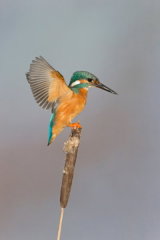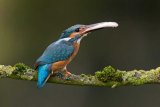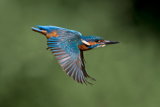4. Kingfisher Portraits
Kingfisher Portraits, Suffolk, spring/summer
High on everyone’s list of subjects to photograph is the kingfisher both static and in action.
This workshop is for portraits of perched birds although it is possible to obtain shots of birds landing and taking off from the perches. See the Kingfisher Diving Workshop for details of action photography.
Due to the nature of concentrating on a single species please register your interest via the contact me page and I will keep you informed as to when the birds become regular/predictable and a date can be arranged for the workshop. This is likely to be May through to August.
Cost of Kingfisher Portrait Workshop
Full day (approx 7.30 am - 3 pm) £150 per person
Equipment: I have a nice selection of photogenic perches including mossy stumps, lichen encrusted twigs, bull rushes and a no-fishing sign but if you wish to bring a couple of props of your own the birds take readily to new perches. These perches are usually set up around 6 metres from the hide. I have a great deal of flexibility at this site to move the perches closer if required but if you share the hide with others a minimum distance may be necessary. I would recommend between 400mm and 600mm (a 300mm on a 1.6 crop factor body is equivalent to a 480mm). A zoom lens is useful if 2 or more birds land on the same perch so you can pull back to get all birds in the frame.
Ethics. There has recently been some debate regarding the ethics concerning baiting and kingfisher photography.
The first point is the safety of the bird. One method commonly used to direct the kingfisher to the spot you wish it to dive is to submerge a glass tank. Whilst I am not aware of any occurrences with the bird entering from the side and hitting the glass I accept this is a possibility so have designed my method to eliminate this risk. My container is padded and can only be entered from directly above thus ensuring the safety of the bird at all times.
The second and perhaps more contentious issue relates to the use of live bait. There is no way around this, kingfishers eat fish! My fish are sourced either from a fish farm or fishing lakes that are so heavily over stocked if I wasn’t using the fish for feeding kingfishers they would be removed and left to die on the lake bank. Every fish that is provided by myself means the birds take one less from the river.
High on everyone’s list of subjects to photograph is the kingfisher both static and in action.
This workshop is for portraits of perched birds although it is possible to obtain shots of birds landing and taking off from the perches. See the Kingfisher Diving Workshop for details of action photography.
Due to the nature of concentrating on a single species please register your interest via the contact me page and I will keep you informed as to when the birds become regular/predictable and a date can be arranged for the workshop. This is likely to be May through to August.
Cost of Kingfisher Portrait Workshop
Full day (approx 7.30 am - 3 pm) £150 per person
Equipment: I have a nice selection of photogenic perches including mossy stumps, lichen encrusted twigs, bull rushes and a no-fishing sign but if you wish to bring a couple of props of your own the birds take readily to new perches. These perches are usually set up around 6 metres from the hide. I have a great deal of flexibility at this site to move the perches closer if required but if you share the hide with others a minimum distance may be necessary. I would recommend between 400mm and 600mm (a 300mm on a 1.6 crop factor body is equivalent to a 480mm). A zoom lens is useful if 2 or more birds land on the same perch so you can pull back to get all birds in the frame.
Ethics. There has recently been some debate regarding the ethics concerning baiting and kingfisher photography.
The first point is the safety of the bird. One method commonly used to direct the kingfisher to the spot you wish it to dive is to submerge a glass tank. Whilst I am not aware of any occurrences with the bird entering from the side and hitting the glass I accept this is a possibility so have designed my method to eliminate this risk. My container is padded and can only be entered from directly above thus ensuring the safety of the bird at all times.
The second and perhaps more contentious issue relates to the use of live bait. There is no way around this, kingfishers eat fish! My fish are sourced either from a fish farm or fishing lakes that are so heavily over stocked if I wasn’t using the fish for feeding kingfishers they would be removed and left to die on the lake bank. Every fish that is provided by myself means the birds take one less from the river.













